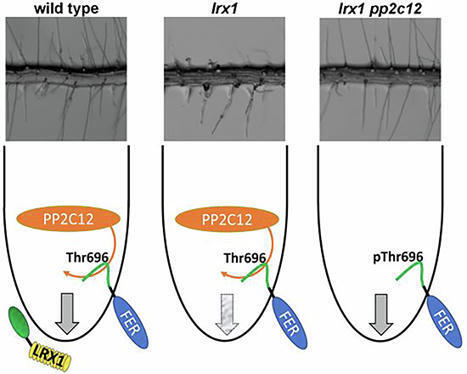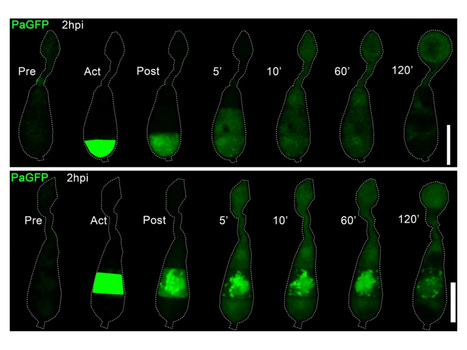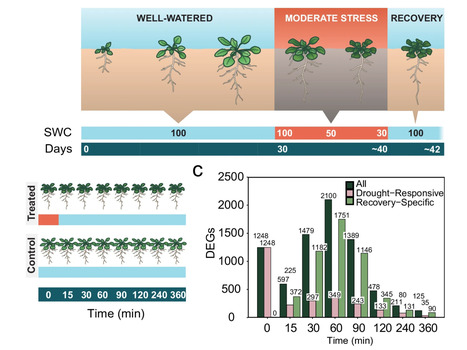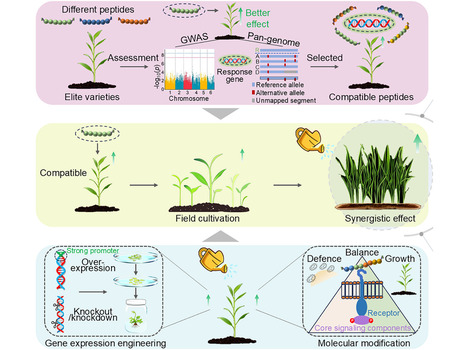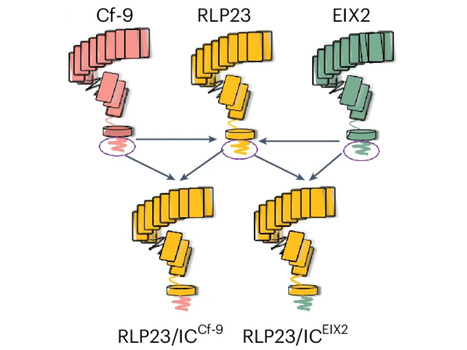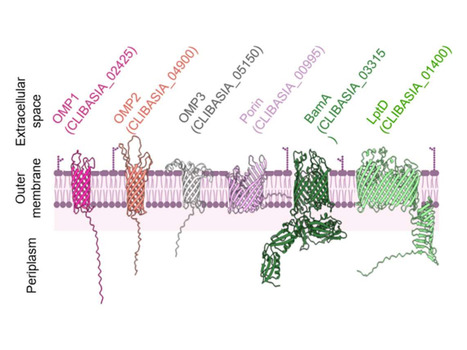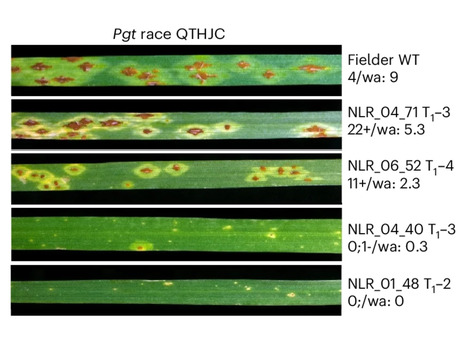 Your new post is loading...
 Your new post is loading...

|
Scooped by
The Sainsbury Lab
December 18, 6:17 AM
|
- The morphology of starch granules is a major determinant of the functional and nutritional properties of starch and is highly variable among cereal species. Much of this morphological variation stems from differences in the spatial and temporal patterns of starch granule initiation in amyloplasts during grain development. Simple granules are thought to arise from a single initiation per amyloplast (e.g. in Brachypodium distachyon), whereas compound granules develop from multiple initiations per amyloplast (e.g. in rice).
- We used live-cell imaging to visualise amyloplasts in the developing endosperm of Brachypodium, using transgenic lines expressing a fluorescent amyloplast reporter.
- We discovered that the simple-type starch granules in Brachypodium can arise from multiple initiations per amyloplast. The amyloplasts showed dynamic changes in their structure and formed two types of stromules: stable stromules that formed a stromal continuum between amyloplasts, and short-lived stromules that were more dynamic. We also observed actin-dependent movement of amyloplasts within endosperm cells, and movement of starch granules within the amyloplasts.
- Our results suggest complex and pleiomorphic amyloplast organisation and mobility that could influence granule formation. This goes beyond the existing ‘one granule, one amyloplast’ model for simple-type granules and advances our understanding of both amyloplast biogenesis and granule formation.

|
Scooped by
The Sainsbury Lab
December 18, 6:07 AM
|
Enterobacter cloacae is a Gram-negative nosocomial human pathogen that inhabits diverse ecological niches. Its genome encodes a conserved set of putative chitin-active enzymes, including a lytic polysaccharide monooxygenase (LPMO), termed EcLPMO, which we functionally characterized in this study. EcLPMO is a tetra-modular protein consisting of an auxiliary activity family 10 (AA10) catalytic domain, two central domains of unknown function (DUF-A and DUF-B), and a C-terminal carbohydrate-binding module (CBM73). Functional assays using full-length EcLPMO and its truncated variants demonstrated that the AA10 domain oxidatively cleaves chitin at the C1 position. The CBM73 module enhances chitin binding and promotes synergy with endogenous chitinases. EcLPMO exhibited synergy with the unimodular chitinase EcChiA, resulting in up to 14-fold and 60-fold increase in GlcNAc release from α- and β-chitin, respectively. Deletion of both DUFs reduced EcLPMO activity. While DUF-A alone and the association of DUF-A and DUF-B showed limited chitin binding, DUF-B alone exhibited no binding, suggesting a distinct role. Using AlphaFold3, we observed that the DUF-B domain contains two highly conserved histidines that coordinate the AA10-bound copper, forming a previously unreported 'inter-domain tetra-histidine copper coordination' center. These findings highlight the structural and functional complexity of EcLPMO and suggest that its accessory domains, particularly DUF-B, may contribute to enzyme stability and substrate interaction. We speculate that DUF-B may protect the LPMO active site from oxidative damage, a feature that could prove crucial in its ecological and pathogenic contexts.

|
Scooped by
The Sainsbury Lab
December 16, 9:06 AM
|
Following the perception of pathogen virulence proteins in plants, nucleotide-binding and leucine-rich repeat immune receptors (NLRs) are activated via a wide range of mechanisms. Singleton NLRs can both perceive effectors and trigger an immune response, whereas other NLRs specialise in either pathogen recognition (sensor NLRs) or activation of the immune response (helper NLRs). Sensor and helper NLRs can function as genetically linked pairs or in unlinked receptor networks. Although growing evidence suggests that NLRs conditionally oligomerise upon activation, our understanding of the resting state of NLRs prior to effector perception remains limited. Here, we investigated the oligomeric state of the genetically linked rice (Oryza sativa) sensor Pik-1 and helper Pik-2 NLR pair prior to effector activation when transiently expressed in Nicotiana benthamiana leaves. We show that both wild-type Pikm-1 and engineered Pikm-1Enhancer sensors associate with Pikm-2 and form ∼1 MDa hetero-complexes in the resting state that accumulate at the plasma membrane. Our findings contribute to the growing evidence that pre-activation mechanisms vary widely across NLRs. This knowledge could be leveraged for disease resistance engineering strategies complementary to approaches focussing solely on effector binding.

|
Scooped by
The Sainsbury Lab
December 16, 9:03 AM
|
Plants have evolved an elaborate cell wall integrity (CWI) sensing system to monitor and modify cell wall formation. LRR-extensins (LRXs) are cell wall-anchored proteins that bind RAPID ALKALINIZATION FACTOR (RALF) peptide hormones and induce compaction of cell wall structures. LRXs also form a signaling platform with RALFs and the transmembrane receptor kinase FERONIA (FER) to maintain cell wall integrity. LRX1 of Arabidopsis thaliana is predominantly expressed in root hairs, and lrx1 mutants develop defective root hairs. Here, we identify a regulator of LRX1-RALF-FER signaling as a suppressor of the lrx1 root hair phenotype. The repressor of lrx1_23 (rol23) gene encodes PP2C12, a clade H phosphatase that interacts with FER and dephosphorylates Thr696 in the FER activation loop in vitro. Expression of FER phospho-mimetic and phospho-null mutants in an lrx1 fer-4 background demonstrates that phosphorylation of FER at Thr696 is essential for suppression of lrx1 phenotypes by rol23. The LRX1-related function of PP2Cs appears clade H-specific. Collectively, our data suggest that LRX1 acts upstream of the RALF-FER signaling module and that PP2C12 inhibits FER via activation-loop dephosphorylation.

|
Scooped by
The Sainsbury Lab
December 16, 8:55 AM
|
The wheat race-specific resistance gene Lr14a encodes an ankyrin-repeat transmembrane domain protein that confers immunity against the fungal pathogen Puccinia triticina, but the underlying mechanisms remain unclear. Here, using a range of biological systems and methods, we show that Lr14a functions as a Ca²⁺-permeable channel crucial for leaf rust resistance in wheat. Interestingly, we also found that the pathogen-inducible expression of Lr14a triggers guard cell hypersensitive response (HR) non-cell autonomously as a mechanism to control pathogen entry. Our results suggest that Lr14a regulates stomatal immunity non-cell autonomously through the mediation of calcium signaling.

|
Scooped by
The Sainsbury Lab
December 16, 8:48 AM
|
Plants encounter diverse pathogens and have evolved a two-layered innate immune system to detect pathogen molecules and activate defense mechanisms that restrict infection. Most cloned plant Resistance (R) genes encode NLR immune receptors. NLR genes are often found in clusters of paralogs with sequence and copy number variation; whether these NLR clusters evolve in response to single or multiple pathogens has been unclear. We report here the isolation of a Phytophthora capsici resistance gene, Rpc2, along with a novel P. infestans resistance gene, Rpi-amr5, from two Solanum americanum accessions. These orthologous genes reside in the Rpi-amr1 cluster, which has previously been associated with resistance to P. infestans. By screening RXLR effector libraries of P. infestans and P. capsici, we identified multiple effectors recognized by both NLRs. Our findings highlight the complexity of NLR clusters and evolution driven by interactions with multiple pathogens. This work will underpin efforts to elevate resistance against Phytophthora pathogens and enhances our understanding of NLR evolution.

|
Scooped by
The Sainsbury Lab
December 16, 8:45 AM
|
Nucleotide-binding and leucine-rich repeat immune receptors of the NRC clade act in one direction, with autoactive helpers able to trigger hypersensitive cell death without their sensor partners.

|
Scooped by
The Sainsbury Lab
December 16, 8:39 AM
|
Precise ligand recognition by closely related leucine-rich repeat receptor kinases (LRR-RKs) is essential for plants to coordinate immunity, development, and environmental adaptation. Here, we show how HAESA-LIKE 3 (HSL3) specifically recognizes the folded, disulfide-stabilized CTNIP/SCREW phytocytokines in Arabidopsis. Quantitative binding assays define a minimal CTNIP4 region required for high-affinity HSL3 interaction and signaling activation. A 2.12 Å crystal structure of the HSL3-CTNIP4 complex reveals a unique C-terminal receptor pocket that accommodates the peptide’s cyclic architecture through a combination of hydrophobic and polar contacts, a feature absent in the closely related HAE/HSL LRR-RKs. The cyclic CTNIP4 fold further establishes a largely hydrophobic interface that bridges HSL3 to the SERK co-receptor, forming a distinct activation surface. Together, these structural, biochemical and physiological insights uncover a previously unrecognised mechanism of peptide perception and receptor activation, highlighting how subtle architectural variations enable precise ligand selectivity among highly conserved plant receptor kinases.

|
Scooped by
The Sainsbury Lab
December 16, 8:37 AM
|
Pattern-triggered immunity (PTI) is initiated when plants detect pathogen-associated molecular patterns (PAMPs) through pattern-recognition receptors (PRRs). How moderate increases in temperature affect this plant immune signalling remains unclear. We explored this by using flg22 and the leucine-rich repeat receptor kinase (LRR-RK) FLS2 as a model receptor-ligand system and Ca2+ signaling as a representative PTI output. A pre-treatment at 28 °C significantly impaired the flg22-induced [Ca2+]cyt influx, leading to a reduced expression of calcium-dependent defence genes, ICS1 and EDS1. This effect correlated with a temperature-dependent reduction in FLS2 abundance. A qualitatively similar inhibition of these responses was observed when membrane fluidity was artificially increased using benzyl alcohol. This suggests that the effect of elevated temperature might act through changes in membrane properties. Artificially restoring FLS2 protein levels rescued flg22-dependent Ca2+ signalling and ICS1 and EDS1 expression in seedlings pre-treated at 28°C or with benzyl alcohol. Together, these findings indicate that increased membrane fluidity reduces FLS2 protein levels, thereby compromising Ca2+ signalling, and probably other, flg22-indcued responses. This highlights a potential mechanistic link between temperature perception, membrane fluidity, and FLS2-dependent calcium signalling, providing insight into how an increase in global temperatures may compromise plant immune responses in the future.

|
Scooped by
The Sainsbury Lab
December 16, 8:30 AM
|
The morphology of starch granules is a major determinant of the functional and nutritional properties of starch and is highly variable among cereal species. Much of this morphological variation stems from differences in the spatial and temporal patterns of starch granule initiation in amyloplasts during grain development. Simple granules are thought to arise from a single initiation per amyloplast (e.g., in Brachypodium distachyon), whereas compound granules develop from multiple initiations per amyloplast (e.g., in rice). Using live-cell imaging in transgenic Brachypodium lines expressing a fluorescent amyloplast reporter construct, we discovered that simple-type starch granules in Brachypodium can arise from multiple initiations per amyloplast. The amyloplasts showed dynamic changes in their structure, the formation of stromules, and the movement of both the amyloplast within the cell and the starch granules within the amyloplasts. Our results suggest complex and pleiomorphic amyloplast organisation and mobility that can influence starch granule formation and morphology. This goes beyond the existing ‘one granule, one amyloplast’ model for simple-type granules, and advances our understanding of both amyloplast biogenesis and granule formation.

|
Scooped by
The Sainsbury Lab
October 13, 8:22 AM
|
The blast fungus Magnaporthe oryzae infects plants using a specialised infection structure called an appressorium that generates physical force to break the rice leaf cuticle. Appressorium development follows a cell cycle-controlled morphogenetic program, requiring autophagy-associated cell death of the fungal spore from which the infection cell develops. How proliferative growth of the fungus is regulated at the same time as programmed cell death, however, is unknown. In this study, we provide evidence that each cell of the conidium undergoes a separate developmental program, which is necessary for plant infection. Using quantitative live-cell imaging, we monitored trafficking of ten organelle types during appressorium morphogenesis in a wild-type M. oryzae strain and isogenic ∆atg8 autophagic mutant. High-resolution microscopy using a photoactivatable green fluorescent protein revealed that organelle trafficking occurs from a single conidium cell into the appressorium, while the remaining two cells undergo autophagy. Organelle inheritance operates independently of cell cycle checkpoints but is always associated with spore germination. We furthermore defined the temporal sequence of organelle movement and de novo organelle biogenesis in the incipient appressorium using photoconvertible fluorescent localisation microscopy. Taken together, our study reveals how synchronous spatiotemporal control of autophagy and organelle trafficking is necessary for rice blast infection.

|
Scooped by
The Sainsbury Lab
October 13, 6:08 AM
|
Plant cells survey and modulate their cell walls to control their shape and anisotropic growth. Signaling mediated by the plant steroid hormones brassinosteroids (BR) plays a central role in coordinating cell wall status and cell growth, and alterations in the cell wall-BR feedback loop leads to life-threatening defects in tissue and cellular integrity. How the status of the cell wall is relayed to BR signaling remains largely unclear. Increasing evidence shows that RAPID ALKALANIZATION FACTORs (RALFs), a class of secreted peptides, play structural and signaling roles at the cell surface. Here, we show that loss of RALF signaling mediated by the plasma membrane-localized RALF receptor complex FERONIA (FER)-LORELEI-LIKE GPI-anchor protein 1 (LLG1) leads to defects in cell morphology, organization, and composition of the cell wall-including pectin methylation status-and to an increase in BR signaling. We observed that increase in BR signaling mitigates the cellular defects associated with the loss of FER-mediated RALF signaling. We show that perception of RALF23 promotes the formation and signaling activity of the main BR receptor complex formed by BRASSINOSTEROID INSENSITIVE 1 (BRI1) and BRI1-ASSOCIATED KINASE 1 (BAK1) and that its bioactivity relies on pectin status. Our observations suggest a model in which RALF peptides operate at the nexus between cell wall status and BR signaling, capable of inducing changes in the cell wall as well as functioning as a cell-wall-informed signaling cues initiating a feedback loop that solicits BR signaling and coordinates cell morphogenesis.

|
Scooped by
The Sainsbury Lab
October 13, 6:04 AM
|
All organisms experience stress as an inevitable part of life, from single-celled microorganisms to complex multicellular beings. The ability to recover from stress is a fundamental trait that determines the overall resilience of an organism, yet stress recovery is understudied. To investigate how plants recover from drought, we examine a fine-scale time series of RNA sequencing starting 15 min after rehydration following moderate drought. We reveal that drought recovery is a rapid process involving the activation of thousands of recovery-specific genes. To capture these rapid recovery responses in different Arabidopsis thaliana (A. thaliana) leaf cell types, we perform a single-nucleus transcriptome analysis at the onset of drought recovery, identifying a cell type-specific transcriptional state developing independently across cell types. To further validate the cell-type specific transcriptional changes observed during drought recovery, we employ spatial transcriptomics using multiplexed error-robust fluorescence in situ hybridization (MERFISH), revealing anatomical localization of recovery-induced gene expression programs across Arabidopsis leaf tissues. Furthermore, we reveal a recovery-induced activation of the immune system that occurs autonomously, and which enhances pathogen resistance in vivo in A. thaliana, wild tomato (Solanum pennellii) and domesticated tomato (Solanum lycopersicum cv. M82). Since rehydration promotes microbial proliferation and thereby increases the risk of infection, the activation of drought recovery-induced immunity may be crucial for plant survival in natural environments. These findings indicate that drought recovery coincides with a preventive defense response, unraveling the complex regulatory mechanisms that facilitate stress recovery in different plant cell types. Post-drought rehydration triggers a preventive immune response in plants, revealing targets to enhance crop resilience by linking drought stress recovery with improved pathogen resistance.
|

|
Scooped by
The Sainsbury Lab
December 18, 6:08 AM
|
Subjects Bacterial techniques and applicationsFungal biologySymbiosis Eukaryotes often host prokaryotic cells inside their own cells. Hosts of such ‘endosymbionts’ can rely on these organisms for metabolism or the production of other necessary molecules.

|
Scooped by
The Sainsbury Lab
December 16, 9:09 AM
|
Angiosperm seed formation requires the coordinated development of the products of double fertilization, the embryo and the endosperm. The endosperm mediates efficient nutrient transfer from surrounding maternal tissues to the developing embryo. This function requires a polarized tissue organization, which manifests as early polar gene expression and polar cellularization dynamics. We show that the receptor kinase HAIKU2 acts in coordination with the transcription factor WRKY10/MINISEED3 to ensure robust endosperm polarity establishment through the activity of the homeodomain transcription factors WUSCHEL-RELATED HOMEOBOX 8 and 9. This process depends on egg cell fertilization and is mediated through the peptide PATHOGEN-INDUCED PEPTIDE-LIKE 7, which acts as a HAIKU2 ligand. Our results reveal how a molecular paracrine dialogue between the embryo and endosperm ensures optimal seed developmental coordination.

|
Scooped by
The Sainsbury Lab
December 16, 9:05 AM
|
Lichens are symbiotic associations between filamentous fungi and photosynthetic micro-organisms, such as algae or cyanobacteria, that result in a single anatomically-complex structure that can thrive in environments inhospitable to most organisms, including arctic tundra, high mountains, and deserts. Recent evidence suggests that lichens may be even more complex than previously appreciated, containing multiple microbial constituents that operate as mini-ecosystems, but how genomes of the principal fungal symbiont (which provides the majority of biomass in lichen tissue) have been shaped during evolution is largely unexplored. Recently, giant transposable elements called Starships have been found in many genomes of filamentous fungi, but to which extent they occur in lichen-forming fungi is not known. In this report, we describe a Starship-like element from the lichen fungus Xanthoria parietina. This element, named Tangerine, contains several genes that have signatures of horizontal gene transfer from non-lichen-forming fungi, most likely from black yeasts of the Chaetothyriales, that are often lichen-associated. Furthermore, the “captain” gene responsible for transposition of the Starship defines a small lichen-specific clade of tyrosine recombinases within clade 1 of the tyrosine recombinase typology, suggesting a longstanding association of these elements with lichen-forming fungi. Internal repeats within Tangerine, and other sites in Xanthoria genomes, are affected by repeat-induced point mutation (RIP), a mechanism of genome defense against transposable elements, consistent with fungal sexual reproduction which always precedes new lichen formation by Xanthoria. We conclude that Starships may have played a significant, yet hitherto unrecognized role, in lichen genome evolution.

|
Scooped by
The Sainsbury Lab
December 16, 8:58 AM
|
Global agriculture faces critical challenges due to the overreliance on chemical pesticides, driving an urgent need for eco-friendly biopesticides and biostimulants (BioP&S). Plant-derived peptides, evolved as natural regulators of growth, development, and stress adaptation, offer immense potential as biodegradable and biocompatible alternatives. However, their commercialization remains constrained by limited exploration of the diversity and activity, high production costs, incomplete ecological risk evaluations, and undefined application scenarios. This Perspective overviews emerging discoveries and proposes integrated frameworks for plant peptide identification, molecular design, biomanufacturing, and ecological impact assessments integrated with germplasm development and field application systems. To overcome existing bottlenecks, we discuss the integrative potential of emerging technologies that synergistically combine artificial intelligence for high-throughput peptide discovery and de novo structural refinement, nanotechnology for enhancing environmental resilience and targeted delivery, and synthetic biology for developing industrial biomanufacturing platforms. We emphasize the need to align phytopeptide BioP&S with compatible germplasm resources, stage-specific crop requirements, and complementary chemical pesticides to maximize their efficacy, cost-effectiveness, and trait-specific agronomic performance by integrating with precision agriculture systems. Future advancements will rely on interdisciplinary innovations and policy support to unlock their full potential in enhancing crop resilience, productivity, and quality while ensuring ecological sustainability.

|
Scooped by
The Sainsbury Lab
December 16, 8:49 AM
|
Lichens are symbiotic assemblies consisting of multiple organisms, chiefly a fungus and a photosynthetic microorganism, or photobiont. Among diverse photobionts, the most prevalent is the chlorophyte alga Trebouxia. We produced a chromosome-level assembly of Trebouxia sp. ‘A48’, a photobiont of Xanthoria parietina. The genome was assembled into 20 contigs, of which 16 had telomeric repeats at both ends and likely represent complete chromosomes. We compared this genome with those of other Trebouxia species and analyzed it to investigate adaptations to the lichen lifestyle. We then used the genome to profile gene expression in axenic culture and in lichen thalli. The predicted secretome is enriched in hydrolases and redox enzymes and contains carbohydrate-binding proteins potentially involved in cell-to-cell recognition and adhesion. We identified genes potentially involved in carbon concentrating and confirmed two instances of ancient horizontal gene transfer from fungi. The genome and the strain of Trebouxia sp. ‘A48’ provide a resource for the community to research algal evolution and lichen symbiosis.

|
Scooped by
The Sainsbury Lab
December 16, 8:46 AM
|
Intracellular immune receptors protect plants from microbial invasion by detecting and responding to pathogen-derived effector molecules, often triggering cell death responses. However, pathogen effectors can evolve to avoid immune recognition, resulting in devastating diseases that threaten global agriculture. Here, we show that an integrated Exo70 domain from the barley NLR RGH2 can interact with both the rice blast pathogen effector AVR-Pii and a closely related wheat blast variant. We used structure-led engineering to develop RGH2+ that shows increased binding affinity towards AVR-Pii variants and increased cell death responses on heterologous expression in Nicotiana benthamiana. Infection assays in transgenic barley lines carrying RGH2+ with the paired NLR RGH3 indicate a reduced susceptibility to blast strains expressing AVR-Pii variants. These results demonstrate the potential of engineering NLR receptors as an effective strategy for improving resistance towards one of the most destructive diseases affecting cereal production.

|
Scooped by
The Sainsbury Lab
December 16, 8:43 AM
|
Plant science education needs urgent attention. Skilled plant scientists are needed to address major environmental and societal challenges, and global communities require plant-aware professionals to drive impactful policy, research and environmental stewardship. This manifesto was collaboratively generated by a community of educators who gathered to reflect on the state of plant science education. The forward-facing document provides a clear strategy for plant science education, complementing existing research strategies. Five themes were identified as essential for meeting the evolving needs of plant science, educators and learners: (i) plants must be at the centre of an education that addresses global challenges and societal values; (ii) plant science education must prepare students for their futures using bold and effective pedagogies; (iii) equity, diversity and inclusion must be robustly embedded in educational practices; (iv) local and strategic partnerships (with industry and beyond) are required to strengthen academic education; and (v) plant science educators need resources and opportunities to develop and connect. The manifesto is intended as a framework for change. Educators, funders, publishers, industry representatives, policymakers and all other members of our communities must commit to sustained investment in plant science education. By proactively and collectively embracing the recommendations provided, the sector has an opportunity to cultivate a new generation equipped with the knowledge, skills and passion to unlock the full potential of photosynthetic organisms.

|
Scooped by
The Sainsbury Lab
December 16, 8:38 AM
|
Effector-triggered immunity (ETI) is a major defence strategy in plants and is frequently associated with the hypersensitive response (HR), a localized form of programmed cell death long assumed to be essential for pathogen resistance. However, the causal relationship between HR and effective immunity remains unresolved. We show that the Arabidopsis cbp60g sard1 double mutant exhibits exaggerated ETI-associated HR but only partial resistance to bacterial and oomycete pathogens, thereby genetically uncoupling cell death from disease resistance without pleiotropic defects. Genome-wide transcriptome profiling reveals that the absence of CBP60g and SARD1 disrupts the balance between immune activators and suppressors, including reduced induction of the Nudix hydrolase NUDT7. Overexpression of NUDT7 diminishes but does not abolish the heightened HR phenotype in cbp60g sard1 mutant, indicating that multiple negative regulators act redundantly to restrain immune-associated cell death. These findings demonstrate that HR is not an obligatory determinant of effective resistance and provide mechanistic insight into how plants coordinate transcriptional networks to balance pathogen defence with the containment of host cell death. By refining the relationship between HR and immunity, this work challenges a long-standing paradigm in plant biology and advances our understanding of immune regulation.

|
Scooped by
The Sainsbury Lab
December 16, 8:35 AM
|
Effector-triggered immunity (ETI) can be defined as immune responses activated upon specific recognition of a pathogen effector protein by its cognate plant immune receptor protein. This classic gene-for-gene model of the interaction of one pathogen effector, also known as an Avirulence (Avr) gene, with one plant immune receptor gene, known as a Resistance (R) gene has been documented since the 1950s. Since then, different types of recognition that deviate from the gene-for-gene model, for example, immune receptor pairs and immune receptor networks, have been identified. In addition, while many R genes encode NLR (nucleotide binding, leucine rich repeat) proteins, R genes that encode only parts of NLR domains, and non-NLR encoding R genes such as tandem kinases have been identified, broadening the immune receptor repertoire in plants. In recent years, there have been significant advances in understanding the molecular mechanisms of NLR intracellular immune receptors in plants, including how they are inhibited, activated, and regulated. This review covers recent developments in ETI initiation mechanisms and in plant NLR biology.

|
Scooped by
The Sainsbury Lab
October 20, 5:22 AM
|
Conventional plant resistance breeding has primarily focused on intracellular immune receptors, while cell-surface pattern recognition receptors (PRRs) have been underexplored because of their comparatively modest contributions to resistance. However, PRRs offer untapped potential for crop improvement. Here we demonstrate that the Arabidopsis receptor-like protein RLP23, which recognizes molecular patterns from three distinct microbial kingdoms, confers broad-spectrum resistance when introduced into the Solanaceae crop tomato. We also identify the C-terminal domain of RLPs as crucial for ensuring compatibility and efficacy during heterologous expression. Targeted engineering of the C-terminal domain significantly enhances RLP23 and its use, enabling transfer of robust resistance against bacterial, fungal and oomycete pathogens to tomato plants without compromising yield. We extend this RLP engineering strategy to rice and poplar, highlighting its broad applicability. These findings establish a versatile framework for PRR-based engineering, opening additional avenues for sustainable crop protection. Engineering an immune receptor improves resistance to bacterial and fungal pathogens in a variety of plants.

|
Scooped by
The Sainsbury Lab
October 13, 6:10 AM
|
Plants secrete a variety of proteases as a defense response during infection by microbial pathogens. However, the relationship between their catalytic activities and antimicrobial functions remains largely unknown. Particularly, few biologically relevant substrates of these proteases have been identified. Huanglongbing (HLB) has been a major threat to the citrus industry worldwide. The HLB-associated bacterium, Candidatus Liberibacter asiaticus (Las), was previously shown to deploy an inhibitor of papain-like cysteine proteases (PLCPs) to promote disease in citrus. In this study, we identified an outer membrane protein (OMP) of Las, LasOMP1, as a substrate of the citrus PLCP CsRD21a. LasOMP1 is one of the most highly expressed genes in Las. CsRD21a cleaves LasOMP1 and produces cleaved peptide products, which could be detected in vitro and in HLB-diseased citrus plants. We found that CsRD21a targets the N-terminal portion of LasOMP1, potentially at an extracellular loop region. Importantly, transgenic sweet orange overexpressing CsRD21a showed reduced Las titers and delayed disease symptoms, highlighting that engineering this protease is a promising strategy to enhance HLB resistance in citrus. Together, our work reveals a pathogen-derived substrate of plant PLCPs and highlights bacterial OMPs as direct targets of plant defense.

|
Scooped by
The Sainsbury Lab
October 13, 6:06 AM
|
Protecting crops from diseases is vital for the sustainable agricultural systems that are needed for food security. Introducing functional resistance genes to enhance the plant immune system is highly effective for disease resistance, but identifying new immune receptors is resource intensive. We observed that functional immune receptors of the nucleotide-binding domain leucine-rich repeat (NLR) class show a signature of high expression in uninfected plants across both monocot and dicot species. Here, by exploiting this signature combined with high-throughput transformation, we generated a wheat transgenic array of 995 NLRs from diverse grass species to identify new resistance genes for wheat. Confirming this proof of concept, we identified new resistance genes against the stem rust pathogen Puccinia graminis f. sp. tritici and the leaf rust pathogen Puccinia triticina, both major threats to wheat production. This pipeline facilitates the rapid identification of candidate NLRs and provides in planta gene validation of resistance. The accelerated discovery of new NLRs from a large gene pool of diverse and non-domesticated plant species will enhance the development of disease-resistant crops. Rapid discovery of functional resistance genes is enabled by a high-expression signature and high-throughput transformation. This approach identified 31 new resistance genes for wheat and can be applied across crops to support food security.
|
 Your new post is loading...
Your new post is loading...
 Your new post is loading...
Your new post is loading...








